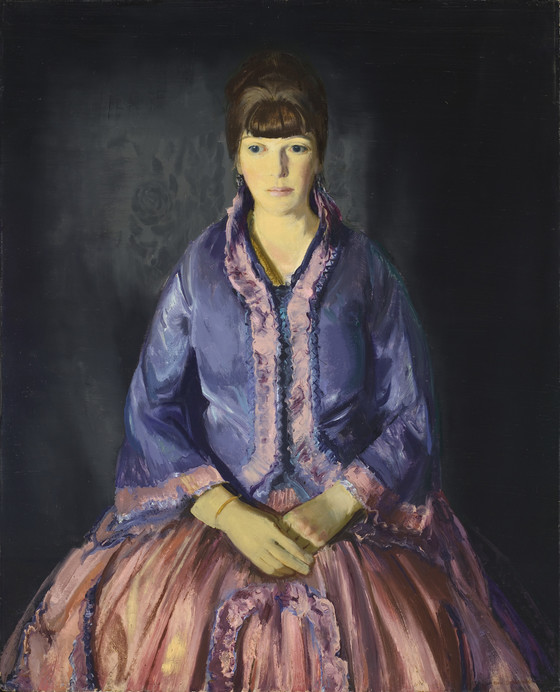Curator Notes
Many artists are fond of painting their family members. There are several reasons for this. Spouses, children, and other relatives tend to be close at hand and consequently often available, and they pose for free. In the case of spouses, often there is also a romantic interest that strengthens the bond between sitter and painter. That may have been the case with the early-twentieth-century American realist George Bellows, who painted his wife numerous times throughout their marriage. In fact, it was Bellowss depiction of his wife, Emma, in the summer of 1919 that led him to focus increasingly on portraiture.
In 2007, the Margaret and Raymond J. Horowitz Foundation generously gave LACMA George Bellowss Emma in the Purple Dress, the first of several large-scale, single-figure compositions that the artist painted of his wife. The painting was inspired by a typical wifely action that resulted in a not so typical husbandly response. Emma arrived home from a shopping spree excited about showing George her new purchase, a beautiful bolt of silk that she intended to sew into a skirt to match one of her favorite blouses. George was so impressed by the vivacity of the resulting ensemble that, after the skirt was finished, he quickly painted his wife wearing the new outfit. Evidence that it was a shared enthusiasm is seen in a photograph of Emma (Bellows Papers, Amherst College) holding out her skirt, pleased to be all decked out in the elaborately shirred and ruffled outfit. While Emmas mood in the photograph is lighthearted, the creation of a large canvas inspired a more somber mood. Emma is quiet and composed. But her happiness as well as Georges relish in painting her is clearly expressed through the exuberant brushwork and the sheen of the fabric.
Years after the painting was created, Emma noted that she did not know why he [George] called it Emma in the Purple Dress, since the skirt was rose-colored and the jacket blue. Historians have suggested that Bellows changed the hues as a matter of artistic license. While that is also true, Bellowss ultimate choice of colors may have resulted from the artists relationship with Hardesty Maratta, a paint supplier who also dabbled in color theory. Robert Henri, John Sloan, and other New York colleagues of Bellows avidly experimented with Marattas ideas, especially his use of triads of complementary colors, chosen like notes of a musical scale, to establish a particular harmony and mood. Marattas specially prepared paints encouraged a rich palette such as that seen in Emma in the Purple Dress.
Emma in the Purple Dress points to a new direction in Bellowss art. His formal portraits of the 1920s reveal a new seriousness with their balanced and severely geometrical compositions and dramatic dark backgrounds, a seriousness that relates to the art of Thomas Eakins, whose 1917 retrospective at New Yorks Metropolitan Museum of Art greatly impressed Bellows. Like Eakins, Bellows began to focus more on the character and inner life of his sitters. The quiet intensity of Emma suggests a poignancy and a sense of the heroic and tragic. It is this mood that enabled Bellows to depart from the contemporaneity of a photograph and his earlier genre paintings to create timeless images such as Emma in the Purple Dress.
More...



